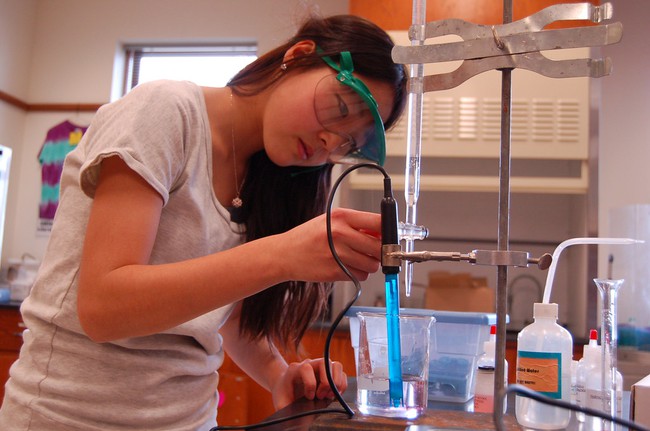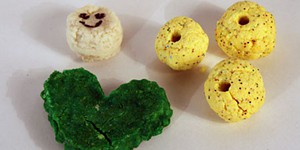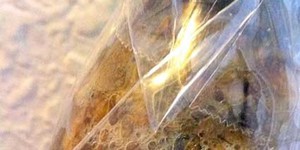Fourth Grade, Green Chemistry Science Projects (4 results)
The goal of green chemistry is to make sure that chemical processes and products are produced in ways that reduce or eliminate the use and creation of toxic material. It encourages the use of as little energy and as few materials as possible and emphasizes using renewable resources. The idea is to be environmentally friendly and sustainable from the beginning of the process rather than figure out how to treat waste after a product is made or discarded.

Green chemistry can be applied to improve existing products or processes. For example, green chemistry is being applied to clothing manufacturing to make the creation of synthetic fabrics more environmentally friendly and ensure that the dyes used to color all clothes use fewer water resources and do not pollute. The same green chemistry principles can be used to make new products like biodiesel made from plants, to replace diesel made from fossil fuels.
The twelve principles of green chemistry provide a framework for scientists and engineers to follow when designing new products or improving existing materials and processes.
- Waste prevention: Instead of treating or cleaning up waste in the end, prevent it from being made.
- Atom economy: Incorporate as much of the starting materials (atoms) into the final product as possible.
- Less hazardous chemical synthesis: When creating complex compounds from simpler materials (chemical synthesis), focus on using and creating materials that do not harm humans or the environment.
- Design safer chemicals: When designing chemical products, make ones that are effective (do the job intended) but have little or no toxicity.
- Safer solvents and auxiliaries: The use of chemicals like solvents, separation agents, etc., that help a chemical process should be either eliminated or, if that isn't possible, made as environmentally friendly as possible.
- Design for energy efficiency: Run chemical reactions at room temperature and pressure whenever possible as it takes extra energy to heat, cool, or alter pressure.
- Use renewable feedstocks: As much as possible, raw materials (also called feedstocks) should come from renewable sources instead of ones that can be depleted. Examples of renewable feedstocks include agricultural products and waste from other processes.
- Reduce derivatives: Derivatization, like using blocking or protecting groups or any temporary modification to a compound, should be avoided if possible. Creating derivatives uses additional reagents and may create more waste.
- Use catalysts: Minimize waste by using catalytic reactions. Catalysts are effective in small amounts and can carry out a single reaction many times. They are preferable to stoichiometric reagents, which are used in excess and carry out a reaction only once.
- Design for degradation: Design chemical products to break down to harmless substances after use so that they do not accumulate in the environment.
- Real-time pollution prevention: Include in-process, real-time monitoring and control during synthesis to minimize or eliminate the formation of byproducts (unwanted products).
- Minimize the potential for accidents: Choose chemicals and their physical forms (solid, liquid, or gas) to minimize the potential for chemical accidents, including releases to the environment, explosions, and fires.
|
Select a resource
Sort by
|
"Plastic made from milk" —that certainly sounds like something made-up. If you agree, you may be
surprised to learn that in the early 20th century, milk was used to make many different plastic
ornaments —including jewelry for Queen Mary of England! In this chemistry science project, you can figure out the best recipe to make your own milk plastic (usually called casein plastic) and use it to make beads, ornaments, or other items.
Read more
Featured
Have you heard that garlic powder is supposed to inhibit the growth of bacteria? Which do you think would make a better disinfectant: a solution of garlic powder or a solution of bleach? This project shows you a straightforward way to compare the effectiveness of different disinfectants (or other antimicrobial agents), by measuring zones of inhibition on a culture plate.
Read more
What should you NOT forget when going outside on a sunny day? To put sunscreen on! Sunscreen is important because it protects your skin from sunburn. But there are so many sunscreens to choose from: different methods of application (sprays and lotions), different Sun Protection Factors (SPFs), and different ingredients. Which one is best? In this science project, you will test the effectiveness of different sunscreens and find out how water-soluble they are.
Read more
New
Does your dog get bored when you are not home? Do you ever toss them a few treats right before you head out the door? What if you could keep them busy by automatically dispensing treats throughout the day? What about training them to sit in a certain place or even press a button by automatically rewarding them with treats? In this project you will build your own automatic dog (or cat, or other pet) treat dispenser that you can customize to react to different sensors.
Read more
Have you ever dreamed of a world where you could take the scraps from last night's dinner and toss them into your car's fuel tank and make gas? Well, we're not quite in "Back to the Future" yet, but in this energy science fair project, you'll discover that food scraps, dead plants, sawdust, and other decaying organic matter, called biomass are a rich source of energy. You can get energy out of biomass by burning it, turning it into a liquid, or by turning it into a gas called biogas. You've…
Read more
Mowing the lawn is hard work, especially on a warm day. Not only do you have to mow the grass, but you also have to dispose of the clippings. Some people add the clippings to a compost pile in their yard, which is a great idea. But did you know that some grasses can be used as a source of energy? In this energy science fair project, you will learn more about a type of energy called biomass energy. You will grow different kinds of grasses and see which type of grass gives you the most biomass,…
Read more
|











